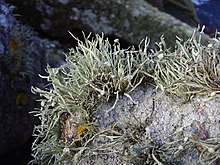| Ramalina siliquosa | |
|---|---|

| |
| Scientific classification | |
| Domain: | Eukaryota |
| Kingdom: | Fungi |
| Division: | Ascomycota |
| Class: | Lecanoromycetes |
| Order: | Lecanorales |
| Family: | Ramalinaceae |
| Genus: | Ramalina |
| Species: | R. siliquosa
|
| Binomial name | |
| Ramalina siliquosa | |
| Synonyms[1] | |
|
Lichen siliquosus Huds. (1762) | |
Ramalina siliquosa, also known as sea ivory,[2] is a tufted and branched lichen which is widely found on siliceous rocks and stone walls on coastlands round the British Isles, occasionally slightly inland. It grows well above the high-tide mark but is still very tolerant of salt spray. The branches are flattened and grey, and bear disc-like spore-producing bodies. It forms part of the diet of sheep in Shetland and on the coast of North Wales.[3] It is found in Iceland where it has a conservation status of a vulnerable species.[4]
- ^ Cite error: The named reference
urlMycoBankwas invoked but never defined (see the help page). - ^ Sarah Carter (2019). "MOSSES, LICHENS, FUNGI AND FERNS IN CORNISH HEDGES" (PDF). Cornish Hedges Library. p. 10. Retrieved 17 August 2022.
- ^ Cite error: The named reference
urlMarLINwas invoked but never defined (see the help page). - ^ Icelandic Institute of Natural History (1996). Válisti 1: Plöntur (in Icelandic). Reykjavík: Náttúrufræðistofnun Íslands.